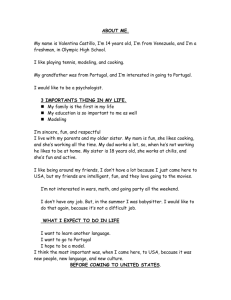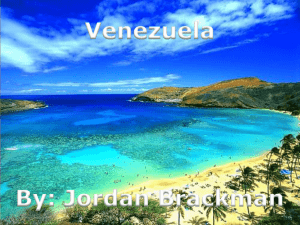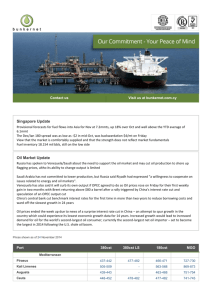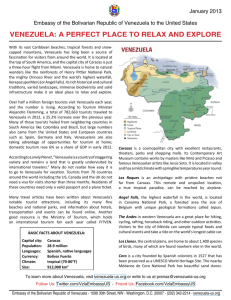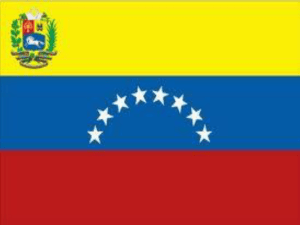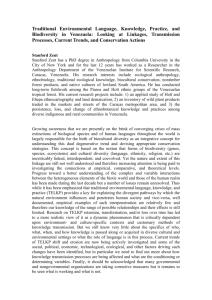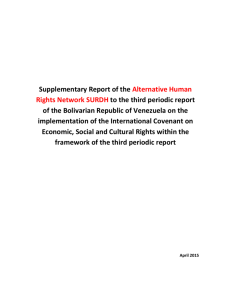FACT SHEET: Urban Agriculture in Venezuela
advertisement
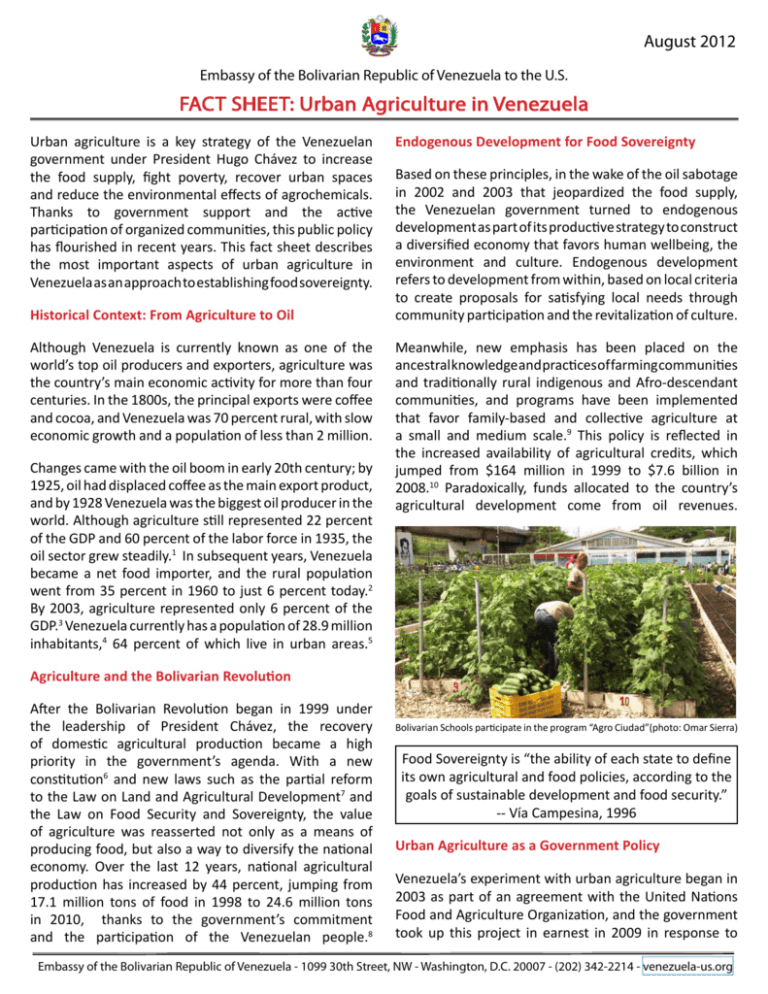
August 2012 Embassy of the Bolivarian Republic of Venezuela to the U.S. FACT SHEET: Urban Agriculture in Venezuela Urban agriculture is a key strategy of the Venezuelan government under President Hugo Chávez to increase the food supply, fight poverty, recover urban spaces and reduce the environmental effects of agrochemicals. Thanks to government support and the active participation of organized communities, this public policy has flourished in recent years. This fact sheet describes the most important aspects of urban agriculture in Venezuela as an approach to establishing food sovereignty. Historical Context: From Agriculture to Oil Although Venezuela is currently known as one of the world’s top oil producers and exporters, agriculture was the country’s main economic activity for more than four centuries. In the 1800s, the principal exports were coffee and cocoa, and Venezuela was 70 percent rural, with slow economic growth and a population of less than 2 million. Changes came with the oil boom in early 20th century; by 1925, oil had displaced coffee as the main export product, and by 1928 Venezuela was the biggest oil producer in the world. Although agriculture still represented 22 percent of the GDP and 60 percent of the labor force in 1935, the oil sector grew steadily.1 In subsequent years, Venezuela became a net food importer, and the rural population went from 35 percent in 1960 to just 6 percent today.2 By 2003, agriculture represented only 6 percent of the GDP.3 Venezuela currently has a population of 28.9 million inhabitants,4 64 percent of which live in urban areas.5 Endogenous Development for Food Sovereignty Based on these principles, in the wake of the oil sabotage in 2002 and 2003 that jeopardized the food supply, the Venezuelan government turned to endogenous development as part of its productive strategy to construct a diversified economy that favors human wellbeing, the environment and culture. Endogenous development refers to development from within, based on local criteria to create proposals for satisfying local needs through community participation and the revitalization of culture. Meanwhile, new emphasis has been placed on the ancestral knowledge and practices of farming communities and traditionally rural indigenous and Afro-descendant communities, and programs have been implemented that favor family-based and collective agriculture at a small and medium scale.9 This policy is reflected in the increased availability of agricultural credits, which jumped from $164 million in 1999 to $7.6 billion in 2008.10 Paradoxically, funds allocated to the country’s agricultural development come from oil revenues. Agriculture and the Bolivarian Revolution After the Bolivarian Revolution began in 1999 under the leadership of President Chávez, the recovery of domestic agricultural production became a high priority in the government’s agenda. With a new constitution6 and new laws such as the partial reform to the Law on Land and Agricultural Development7 and the Law on Food Security and Sovereignty, the value of agriculture was reasserted not only as a means of producing food, but also a way to diversify the national economy. Over the last 12 years, national agricultural production has increased by 44 percent, jumping from 17.1 million tons of food in 1998 to 24.6 million tons in 2010, thanks to the government’s commitment and the participation of the Venezuelan people.8 Bolivarian Schools participate in the program “Agro Ciudad”(photo: Omar Sierra) Food Sovereignty is “the ability of each state to define its own agricultural and food policies, according to the goals of sustainable development and food security.” -- Vía Campesina, 1996 Urban Agriculture as a Government Policy Venezuela’s experiment with urban agriculture began in 2003 as part of an agreement with the United Nations Food and Agriculture Organization, and the government took up this project in earnest in 2009 in response to Embassy of the Bolivarian Republic of Venezuela - 1099 30th Street, NW - Washington, D.C. 20007 - (202) 342-2214 - venezuela-us.org Embassy of the Bolivarian Republic of Venezuela to the U.S. the global food crisis, establishing the Foundation for Training and Innovation to Support the Agricultural Revolution (CIARA) with support from the Republic of Cuba. By late 2009, 191 agricultural production units were created, mainly in the capital city of Caracas. In 2011, the program got a boost from the creation of the Great Mission AgroVenezuela, a national socio-productive program to stimulate agricultural production. Its aims include “strengthening urban agriculture as a new scheme of food mass production in cities.”11 Through CIARA, which is under the Ministry of Agriculture, a new program called “Agro Ciudad” was created to produce food in urban and suburban areas. the elaboration of organic fertilizer, pest and disease management, and other issues. Graduate students in the Bolivarian University’s Agro-Ecology Program conducted 4,574 technical assistance visits to help growers.14 Environmental Sustainability in Cities “Agro Ciudad” helps take advantage of idle lands by coordinating, designing, and applying actions to improve the quality of life of the population. The program has transformed schoolyards, outdoor spaces near offices, buildings, squares, houses and abandoned public areas to put them to use in food production and improve the appearance of cities. Since 2009, over 26 million square feet of idle land has been used for food production. Promoting a Local Solidarity Economy The “Agro Ciudad” Program As of May of 2012, surplus production through “Agro Ciudad” goes to local markets so that residents can buy fresh vegetables and boost the community’s economy. These markets also articulate actions with other productive initiatives through networks of food sales and distribution.15 Three tons of healthy foods are sold at fair prices each week in these local markets, which eliminate intermediaries and pass savings of 50 to 70 percent on to customers. These markets also provide a space for cultural activities surrounding urban agriculture. Popular participation in food production Harvesting the Rewards of Urban Agriculture Under the model of participatory democracy, the program “Agro Ciudad” has been taken up by schools, universities, community councils, cooperatives, families, collectives, socio-productive networks, and other local groups. In its first year, 1,600 people benefited from the program and 12,306 producers were assisted.12 Most of the participation has come from women, children, and senior citizens.13 With an investment of $44 billion, Venezuela currently produces onion, peppers, leeks, basil, celery, eggplant, zucchini, cucumber, cilantro, lettuce, tomato, radish, beets and green beans at a low cost in urban gardens. By July 2012, 25,000 units of agricultural production, including family, community, institutional and school gardens, were opened in 10 priority states throughout the country (Anzoátegui, Aragua, Carabobo, the Capital District, Lara, Miranda, Monagas, Táchira, Vargas and Zulia). Food production in urban areas increased from 457 tons in 2009 to 6,340 tons in May 2012.16 An agricultural production unit in downtown Caracas (photo: Omar Sierra) Training for Healthy, Environmentally Friendly Food “Agro Ciudad” takes an environmentally friendly approach to food production, and training is a key aspect of the program. In 2011, 1,812 training workshops on small-scale food production were held. They provided information about how to build raised planting beds, methods of planting and soil management, Thanks in part to the government’s food and agriculture policies, average annual food consumption in Venezuela has increased by 25 percent over the last 12 years, jumping from 873.7 pounds of food per person consumed in 1999 to 1,102 pounds per person in 2010.17 Embassy of the Bolivarian Republic of Venezuela - 1099 30th Street, NW - Washington, D.C. 20007 - (202) 342-2214 - venezuela-us.org Embassy of the Bolivarian Republic of Venezuela to the U.S. The Venezuelan government has a social vision of the food sector: food is not merchandise, but rather, a fundamental human right. That’s why it has developed independent and sovereign food policies forecasting scenarios of a global food crisis and the use of food as political weapon by opposition sectors, which promote hoarding, smuggling and speculation. Urban agriculture has become a tool of food sovereignty that is becoming popular in Venezuela and strengthens families and communities. Communities are in charge of the urban agriculture projects (photo: Omar Sierra) SOURCES: 1. “Land for People not for Profit in Venezuela,” Gregory Wilpert, Venezuelanalysis, Aug. 23, 2005. http://venezuelanalysis.com/analysis/1310 2. Country Brief, United Nations Food and Agriculture Organization. http:// www.fao.org/countries/55528/en/ven/ 3. “Producto Interno Bruto a precios constantes, según clase de actividad económica, 1995-2003,” National Institute of Statistics of Venezuela. http:// www.ine.gov.ve/cuentasnacionales/PIBconstante.htm 4. “Población total de Venezuela alcanza 28.946.101 habitantes”, AVN, Aug. 8, 2012. http://www.avn.info.ve/contenido/población-total-venezuela-es289-millones-habitantes 5. World Bank. http://data.worldbank.org/topic/urban-development 6. Constitution of the Bolivarian Republic of Venezuela, 2009. http://www. tsj.gov.ve/legislacion/enmienda2009.pdf 7. Gaceta Oficial, Bolivarian Republic of Venezuela. http://corpocentro. vicepresidencia.gob.ve/CFG/LAEEDMH.pdf 8. “Venezuela aumentó producción agrícola en 44% durante los últimos 12 años”, AVN, Mar. 30, 2011. http://www.avn.info.ve/contenido/venezuelaaumentó-producción-agrícola-44-durante-últimos-12-años 9. “Creating an Endogenous Development Culture in Venezuela”, April Howard, Venezuelanalysis, Sept. 8, 2008. http://venezuelanalysis.com/ analysis/3778 10. “The Venezuelan Effort to Build a New Food and Agriculture System”, Christina Schiavoni and William Camacaro, Monthly Review 61:3, Jul.-Aug. 2009. http://monthlyreview.org/2009/07/01/the-venezuelan-effort-tobuild-a-new-food-and-agriculture-system 11. Presentación de Martha Bolívar, Fundación CIARA, 2012. 12. “El proyecto de desarrollo y consolidación de la agricultura urbana”, Fundación CIARA, 2012. http://www.ciara.gob.ve/agricultura_urbana.html 13. “Entrevista a Martha Bolívar,” Omar Sierra, Aporrea, Aug. 7, 2012. http://aporrea.org/desalambrar/n211446.html 14. “El proyecto de desarrollo y consolidación de la agricultura urbana”, Fundación CIARA. 15. “Entrevista a Martha Bolivar”, Aporrea. 16. “Reporte Agricultura Urbana”, Jul. 2012, Fundación CIARA. 17. “Consumo de alimentos del venezolano aumentó 25% en los últimos 12 años”, AVN, May 19, 2012. http://www.avn.info.ve/contenido/consumo-alimentos-del-venezolano-aumentó-25-útimos-12-años For more information, visit our website at venezuela-us.org or write to us at prensa@venezuela-us.org Follow Us: Twitter.com/VzlaEmbassyUS Friend Us: Facebook.com/VzlaEmbassyUS Embassy of the Bolivarian Republic of Venezuela - 1099 30th Street, NW - Washington, D.C. 20007 - (202) 342-2214 - venezuela-us.org

